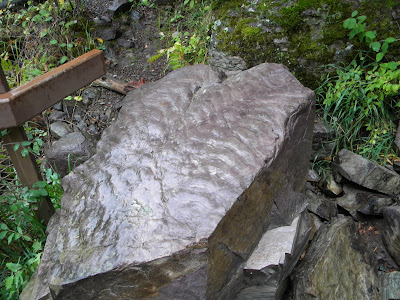In the mid 1860s, an Aurora businessman named Thomas Gaff and his brother James decided that a brewery would be a profitable addition to his shipping and distilling empire. Thus was born Aurora's first brewery--the Aurora Brewing and Malting Company - located on the Ohio River at the bottom of Market Street. By 1874, the brewery had expanded into a six-story stone and brick building that stretched for 300 ft along Market Street and changed its name to the T & J.W. Gaff Company. Because of the steep hillside along the river, the entrance to the main offices on Market Street was actually the third floor. The brewery's primary product was "Aurora Lager Beer" (later shortened to simply "Aurora Beer")
In 1877, Thomas Gaff retired to his mansion "Hillforest" and the brewery reorganized as the Crescent Brewing Company with James W. Gaff as President. For the next 16 years, even though James Gaff passed away in 1879, the brewery did well and expanded its markets --especially into the southern states of North Carolina and Georgia. The brewery plant was upgraded with a large engine room, ice-making machines and ice storage rooms, as well as rock-lined cellars for lagering (fermenting at cold temperatures) the beer.
 |
| A postal envelope showing a "factory scene" from the early 1880s. Although these printed images often bear no resemblence to reality, the brewery building is more or less accurate on this one. |
In the late 1880s, the brewery attracted the attention of a British brewing syndicate headed by the famous Watney of London brewery and Crescent was bought by the syndicate and merged with the Jung Brewing Co of Cincinnati. While the sale was great timing for the original owners, the British syndicate soon ran into the fierce Cincinnati brewery competition (Christian Moerlein, Windisch-Mulhauser, and Hauck were much larger operations), just as the U.S. prohibition movement was gaining ground. Losing money, the syndicate closed the Crescent brewery in 1893, and moved all of their brewing operations to Cincinnati.
 |
| Crescent Brewing Co letterhead from the early 1890s showing a highly stylized factory scene typical of that era. (Photo from John Ullrich, long-time photographer in Aurora) |
Over the 27-year history of the Gaff - Crescent brewery, but particularly during the golden years of the 1880s, the brand "Aurora Beer" was promoted with some eye-catching signs and humorous advertising. One of these signs is on display at the Thomas Gaff mansion "Hill Forest" located in Aurora. Another beautiful lithographic sign is known to exist in a private collection. Other promotional items of the era included "Aurora Beer" pocket mirrors and playing cards. The Gaff family also had a captive audience for selling some of their beer -- the Gaff riverboats that plied the Ohio and Mississippi Rivers. The same boats also carried cases of Aurora beer to New Orleans, where it was sent abroad on the high seas for the enjoyment of passengers on the fast clipper ships of the era.
 |
| A 2" diameter pocket mirror with a tout for a Aurora Beer on the back. I guess the thought was that men would notice the ad when their lady friends decided to do a little primping!! |

























